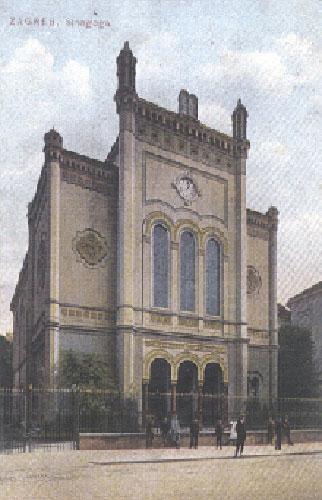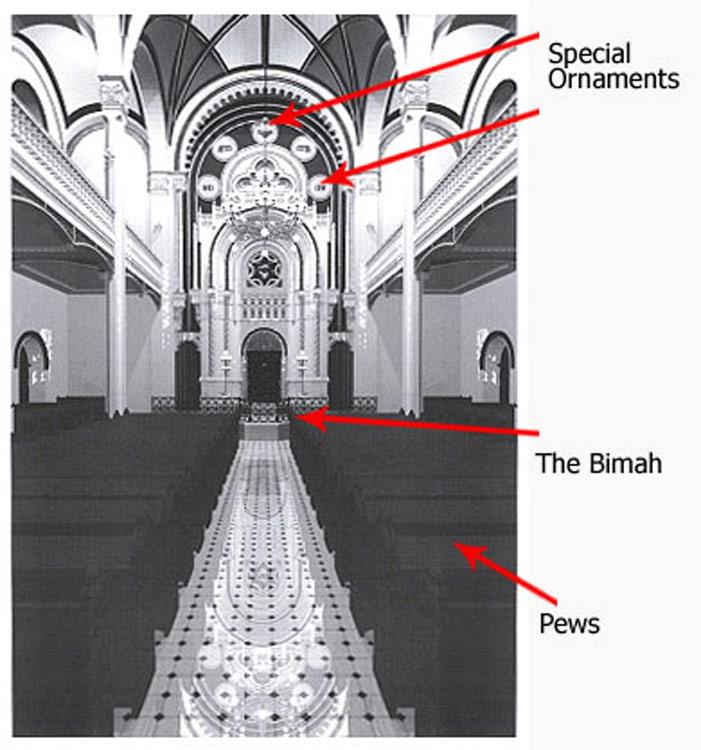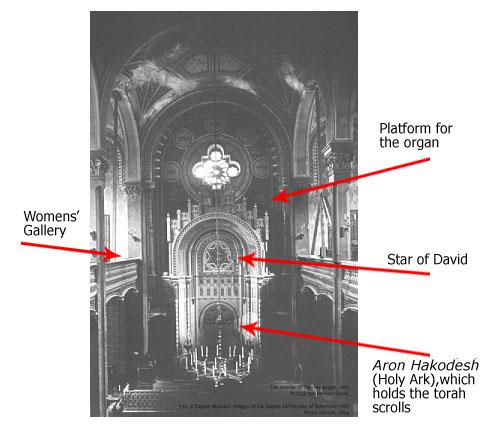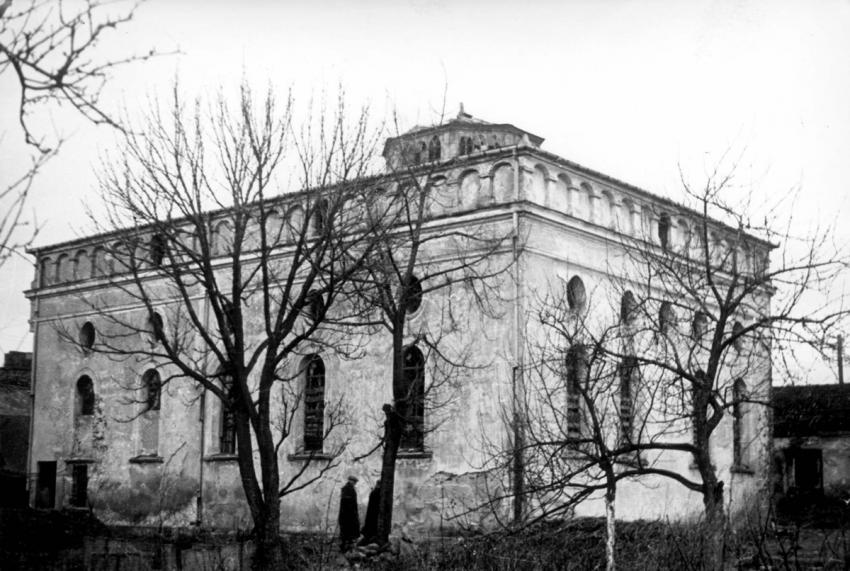Grades: 9 - 12
Duration: 1.5 hours
This lesson provides an opportunity for high-school students to learn about Jewish life in Zagreb before the Holocaust. In this lesson, students will explore Jewish symbols and traditions. They will become acquainted with the community of Zagreb and its unique features within the context of the Jewish world. Learning about Jewish life before the Holocaust is essential for further studying the Nazi era and the Holocaust. By gaining a stronger awareness about how Jews integrated into European culture, students will better relate to the murder of Jews as human beings rather than as statistics. Furthermore, exposing students to a vibrant Jewish community will help students perceive Croatian Jewish people not only as victims but rather as active and involved European citizens.
The synagogue on Praska Street in Zagreb was destroyed by the Ustasha between Fall 1941 and Spring 1942. At that time, Croatian Jews were persecuted and murdered. We, as educators, do not have the means to change the course of history. However, through an educational process with our students, we have the ability to affect the future. Together with our students, we shall symbolically reconstruct the synagogue of Zagreb, listen to testimonies of Croatian Jews, and hopefully gain a better understanding about prewar Jewish life in Europe.
Objectives
- Students will learn the meaning of Jewish symbols.
- Students will be familiarized with Croatian Jewry before World War II.
- Students will learn about the unique characteristics of a minority.
- Students will read testimonies and discuss the importance of using different sources.
Part 1
Begin the lesson with an introduction about the meaning of religious traditions in their students’ own lives by asking them the following questions:
- What is prayer?
- Have you ever prayed? If so, when?
- Can you describe an emotion that you associate with prayer?
- Where do you pray? Do you pray from a prayer book or make up the prayer?
- Do you know the people who come to your place of prayer?
- Did you prefer to pray with a group or by yourself?
- What is your favorite holiday? What are the symbols of that holiday?
- What other religions, besides your own, are you familiar with?
- What is a symbol?
- Give an example of a Christian symbol or Moslem symbol.
- Are you familiar with any Jewish symbols? If so, which ones.
Explain to students that in this lesson they will learn about the Jewish community that lived in Zagreb before the Holocaust.
Show students a photo of Praska Street in the center of Zagreb. Ask students to point to a place where the Jewish synagogue might have stood. Show students a prewar photo of Praska Street in which Zagreb’s synagogue can be seen. Then give each student the photo of the synagogue. Explore the synagogue together with the students; note the arrows that designate the different features of the synagogue.
The Synagogue on Praska Street
Tell students that Zagreb’s synagogue was destroyed during World War II. Their assignment is to rebuild the synagogue. Since they may not be familiar with all of the items in the list of concepts below, they will also have to investigate their meaning. Divide the class into four groups, each of which will receive one list:
Within the Jewish world, there are many different kinds of synagogues, representing different Jewish denominations. Some Orthodox synagogues, the type that was most common up until the 19th century, are very different from the synagogue in Zagreb. An organ, for example, may typically be found in a modern Reform synagogue, but is unheard of in an Orthodox one, as Orthodox Jews do not play musical instruments on Shabbat and holidays.
List of Concepts:
- Building, bimah, rabbi, tallit, Jewish prayer book (siddur), identity
- Aron ha-akodesh, platform for organ, mezuzah, Magen David, Jews in Croatia
- Torah, women’s gallery, seats, menorah, Hebrew, identity
- Front of the synagogue, community (kehilla), special ornaments, Jews in Croatia
Information on these subjects can be gathered from the Internet, local libraries and encyclopedias. For a list which can be used to either confirm the information gathered or as a learning source, click the "Additional Resources" tab above. We recommend that you encourage students to first conduct research on their own. Discuss the possible advantages and disadvantages of each source. For example, make students aware that although the Internet may be a virtually unlimited source of information, at the same time, not all the information found on it is reliable. They should double-check all information they receive.
Students will report on the information they have gathered. Have a concluding discussion on the main symbols found in the synagogue. They can also draw or build a model of the new “old” synagogue.
For further information, see the additional source "The Synagogue of Zagreb 1867-1942".
Part 2
Divide the class into four groups and give them the testimonies below. Ask students to read and answer the questions that follow these testimonies:
Ruth Gat
"We were a Jewish family, not religious, not even traditional, but a Zionist family. Of course, we celebrated the Jewish holidays. I, for instance, didn’t go to school during the holidays, because Jewish children were allowed not to go. For instance, I remember, that on Passover (Pessah), which is seven days long, I didn’t want to miss so much school, so I went. But I didn’t study. I went to the classroom as an observer, to be present in the classroom – that’s the way it was, there was such a thing. The synagogue of Zagreb, which doesn’t exist any more, was demolished, I remember…The most outstanding time, was during the holiday of Pentecost (Shavuot), I remember the synagogue was decorated, full of flowers and green plants, and the children went there like this, with flowers, and I was also sent together with the children. I was a very shy girl, but there was this atmosphere of happiness and joy, which made me feel good there – this I can remember. And after the war, when we could already go out and I came to that place, it was the center of the city, but instead of the synagogue, you could see a fence, made out of boards to block the sight, because there was nothing there – they had destroyed the synagogue."
Vera Levi (Miler)
"Grandfather was already in Croatia. Great Grandfather came from the Austro-Hungarian Empire to Croatia and there my grandfather was born. My grandfather moved to Zagreb. Dad was already born in Zagreb, and studied in the Jewish school. I studied at that school as well. My mother came from the Croatian part that is called Slovenia... All of them were really from Croatia… I had a normal childhood, a happy childhood, a good one. We went on hikes to the mountains. During summer break, we stayed near the beach or in Slovenia. Time passed by pleasantly. My parents were Jews by nationality; they were not traditional; my home was not traditional. But I knew everything and so did my parents. This is the kind of atmosphere I was raised in. Of course there was the synagogue, but it wasn’t in a religious aspect but rather more traditional. I was too young to have any connections with the members of the community. But I did know the principal of the school, Dr. Margel… and Dr. Morris Levi, who was our religious studies teacher, and Dr, Shmuel Romano, who was also a teacher in the school. During religious studies, we learned to read Hebrew letters and we read from the Torah. In Croatian school, we learned the Bible – Biblijaikatekiyam. That was the lesson. We learned all the Bible stories in Croatian and not in Hebrew. In Hebrew, we studied the letters...We also had a Hebrew poetry teacher; he was a cantor and he gave us lessons... And there was also the beautiful synagogue, during the High Holy Days, we played in the synagogue’s yard. Of course, the adults prayed inside the synagogue. What is left in my memory is Rosh Hashanah eve and Yom Kippur. Hannuka! That was a holiday for me..."
Dr. Zeev Nir
"In Zagreb, there was a very active Jewish community, and there was a Jewish school (Zidovska Skola) but I wasn’t sent there, even though we lived closer to the Jewish school than to the one where I studied. My home was completely assimilated. My father wasn’t a Zionist, and neither was anyone else in our family, except for one uncle, who was a Zionist and spoke a strange language (Hebrew), which nobody understood then. On Yom Kippur, they fasted and went to synagogue."
Ephraim Cohen
"At the age of six, I went to the Jewish school in the Jewish community and I studied well. We were raised on secular culture. We were not religious, but there were things from Judaism that remained in our home. My father, I remember, used to fast on Yom Kippur, and I remember that he took me to the Great Synagogue during the holidays. I went to synagogue with my father. Father had a regular reserved seat. And he paid for it. And that was the way I was raised, which means, definitely a Jewish atmosphere, but not an Orthodox one. My father was a community donor."
Iris Reilich
"The community in our city wasn’t big. It was very warm and all the members felt connected to one another. Meetings among Jews were held in the synagogue, where my grandfather was an activist and a Zionist. I, as a child at the time, would visit with the synagogue together with my parents. We were not religious, but life circled around the synagogue. One could say that the Yugoslavian community was not such a religious community. It was a community that felt Jewish and celebrated the holidays. Every holiday, we would go to the synagogue but we hardly learned any Hebrew."
Dan Singer
"I was born in Zagreb. We lived on Malti Street. That was one of the main streets of Zagreb. I remember the synagogue of Zagreb and we know that nothing remains of this great synagogue. We were not religious, but of course, we went to synagogue, especially to the synagogue in Zagreb, which was known for its openness to everyone. There was a vibrant communal life in Zagreb, with many institutions, which dealt with community, charity and education. I also have a photo of Purim. We would go to the synagogue and dress up. It was a monumental synagogue, I remember it as monumental, it might be that it wasn’t really so, with a huge sanctuary and a women’s section with a balcony all around, and the men praying downstairs. There was also a ballroom. It was a center, a real center, where people would meet for many different reasons. It had many kinds of institutions and also taught Hebrew, and other things...I remember only that afterwards my mother told me that they destroyed the synagogue, and not only that, but they even brought a special machine to grind the stones into dust..."
Optional: If possible, it is recommended to invite a Holocaust survivor to speak to the students. Ask the survivor to talk about life before the Holocaust. Together with the students, prepare a list of questions that they would like to ask the survivor.
- How do the witnesses describe the synagogue and its functions?
- Try to identify what kind of need the synagogue fulfilled for him/her in relation to the following aspects: identity, religion, community.
- How was the survivor affected by the destruction of the synagogue?
- What, in your opinion, could have been the reason the Ustasha wanted to destroy the synagogue?
Optional: Ask students to expand their research to other synagogues in Europe before World War II. You can suggest the following communities: Krakow, Poland; Vilna, Lithuania; Bratislava, Slovakia.
It is important to be exposed to the variety of synagogues in different places and in different times. It is highly recommended that the students research at least one more synagogue, or visit one or more, located in their respective cities.
Have a discussion to sum up by asking the following questions:
- What similarities do the different synagogues share?
- How are they different?
- After learning about synagogues, what do you think is the role of the synagogue in the Jewish world?
Lexicon Entries on Jewish Tradition
Bimah
Platform where the Torah is read in the synagogue. In modern synagogues, the bimah is often located in the front of the sanctuary, although in many synagogues it is located in the center.
Tallit
The tallit is a four cornered prayer shawl with ritual fringes or tzitzit attached to each corner. The tallit is worn during the morning prayers on weekdays and on Shabbat and holidays.
Siddur
The Jewish prayer book. Jews pray three times a day. All of these prayers appear in the siddur. The Jewish prayer book, a compilation of Biblical verses, liturgical poems, and blessings, represents the unity of the Jewish world that for 2,000 years was scattered in Europe, America, Africa, and Asia. All Jews prayed and still pray from the same prayer book – the siddur.
Aron Hakodesh
The Holy Ark, where the Torah scrolls are kept. It is the focal point of every synagogue and is traditionally located on the eastern wall, facing Jerusalem, where the Holy Temple once stood. It is considered an act of respect to remain standing while the doors of the Aron Hakodesh are open and the Torah scrolls revealed to the public.
Magen David
The Star of David, the symbol of Judaism. Many synagogues use this symbol on the front of the synagogue to mark the building as a Jewish holy place. Nazi Germany used this symbol to set Jews apart and humiliate them. Marking Jews by forcing them to wear a Star of David on their clothing exposed Jews to violence and abuse; it also became one of the means used to isolate them from the rest of the population, so that they could be later deported to the death camps. In the camps, Jewish prisoners were marked with a Star of David too. Today the Star of David is also the symbol of the State of Israel, and it appears on the state flag.
Torah
The Sefer Torah or Torah scroll contains the Five Books of Moses and is written on parchment made from the skin of a kosher animal. A scribe (Sofer Stam) carefully copies the text according to ancient traditions that determine the shape of the letters, special decorative aspects added to certain letters, the size of the letters and the spaces between sections. There are approximately 245 columns in a Sefer Torah, and each column has 42 lines. No letter may touch another, and if even a single letter is missing or unclear, the Sefer Torah may not be used until it has been repaired.
Menorah
One of the oldest symbols of the Jewish faith is the menorah. It is a seven-branched candelabrum used in the Holy Temple in Jerusalem in ancient times. The book of Exodus contains precise instructions for the construction of the menorah, which was made of pure gold. When the Temple was destroyed by the Romans in 70 CE, they paraded holding the Menorah to publicize their victory, a scene carved into the famous Gate of Titus in Rome. Most, if not all, synagogues have a menorah; sometimes you can see a lamp in today’s synagogues symbolizing the menorah that was used in ancient times in the Holy Temple.
Mezuzah
The mezuzah is a rolled up piece of parchment containing three excerpts from the Bible, one of which is the Shema Yisrael (Hear O Israel) prayer. The parchment is placed in a case and attached to the right doorpost as you enter. It is customary to kiss the mezuzah upon entering and exiting a room.
Women’s Gallery
In Jewish tradition, men and women sit separately during prayer and the study of Torah. In the Jewish world, you can find many different kinds of women’s galleries; some have just a curtain to separate men from women, others a decorative wooden partition, and in many synagogues, the women sit above the sanctuary in a balcony located on the second floor. This separation between men and women derives from the traditional rules of modesty, part of an extensive and elaborate set of rules in Jewish law. It is believed that one should address God with a pure heart and the clearest intentions and that while a home is the place for being together, when praying, one should stand alone without any temptations or distractions.
Hebrew
The Hebrew language has twenty-two letters. It is the language of the Bible and Jewish prayer; it is also the language of the modern State of Israel. For hundreds of years, Hebrew was used mainly as a holy language, for praying and learning Torah. Young children learned how to read, pray, and study in that language. Hebrew letters have been used in decorative symbols in Jewish synagogues. Words like “God,” “soul,” and “Torah” can be found adorning synagogues. Torat Hashem temima meshivat nafesh – God's Torah is perfect, it restores the soul.” These Hebrew words from Psalms (19:8) were inscribed above the Holy Ark in the Zagreb synagogue.
Cantor (Hazan)
The cantor leads the synagogue congregation prayer. During special holiday prayers, there is significance to the special melodies that are sung and to the cantor’s voice.
Rabbi
The leader of the Jewish community. The rabbi is a religious authority, teacher and spiritual advisor to the community. A rabbi must be an expert in Jewish law, which is vast and complicated; he is also authorized to rule on questions of halakha (Jewish law) that community members ask him.
Community (Kehilla)
The community is responsible for the synagogue, a charity (tzedaka), cemetery, burial society and many other public institutions. The community supports and accompanies its members from birth to burial. Some communities offer a maternity hospital for Jewish women; many also have a kindergarten and a Jewish school for children. The community services have developed over the years and community buildings often contain a ballroom for holiday parties, bar mitzvahs and other traditional celebrations. The community enables Jews to maintain their unique identity as a minority living in a non-Jewish state.
Additional Source 2
Snjeska Hnezevic, "The Synagogue of Zagreb 1867-1942", The Synagogue and Zagreb, (Zagreb, Zagreb Jewish Community, 2001), pp.42-46.
Additional Source 3
Ivo Goldstein, "The Genocide against the Jews in the Independent State of Croatia", The Synagogue and Zagreb, (Zagreb, Zagreb Jewish Community, 2001), pp. 20-23.










